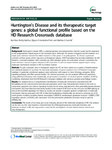Huntington's Disease and its therapeutic target genes: a global functional profile based on the HD Research Crossroads database
| dc.contributor.author | Kalathur, RKR | |
| dc.contributor.author | Hernández-Prieto, MA | |
| dc.contributor.author | Futschik, ME | |
| dc.date.accessioned | 2017-02-07T19:51:26Z | |
| dc.date.available | 2017-02-07T19:51:26Z | |
| dc.date.issued | 2012-12 | |
| dc.identifier.issn | 1471-2377 | |
| dc.identifier.issn | 1471-2377 | |
| dc.identifier.other | 47 | |
| dc.identifier.uri | http://hdl.handle.net/10026.1/8411 | |
| dc.description.abstract |
<jats:title>Abstract</jats:title> <jats:sec> <jats:title>Background</jats:title> <jats:p>Huntington’s disease (HD) is a fatal progressive neurodegenerative disorder caused by the expansion of the polyglutamine repeat region in the <jats:italic>huntingtin</jats:italic> gene. Although the disease is triggered by the mutation of a single gene, intensive research has linked numerous other genes to its pathogenesis. To obtain a systematic overview of these genes, which may serve as therapeutic targets, CHDI Foundation has recently established the HD Research Crossroads database. With currently over 800 cataloged genes, this web-based resource constitutes the most extensive curation of genes relevant to HD. It provides us with an unprecedented opportunity to survey molecular mechanisms involved in HD in a holistic manner.</jats:p> </jats:sec> <jats:sec> <jats:title>Methods</jats:title> <jats:p>To gain a synoptic view of therapeutic targets for HD, we have carried out a variety of bioinformatical and statistical analyses to scrutinize the functional association of genes curated in the HD Research Crossroads database. In particular, enrichment analyses were performed with respect to Gene Ontology categories, KEGG signaling pathways, and Pfam protein families. For selected processes, we also analyzed differential expression, using published microarray data. Additionally, we generated a candidate set of novel genetic modifiers of HD by combining information from the HD Research Crossroads database with previous genome-wide linkage studies.</jats:p> </jats:sec> <jats:sec> <jats:title>Results</jats:title> <jats:p>Our analyses led to a comprehensive identification of molecular mechanisms associated with HD. Remarkably, we not only recovered processes and pathways, which have frequently been linked to HD (such as cytotoxicity, apoptosis, and calcium signaling), but also found strong indications for other potentially disease-relevant mechanisms that have been less intensively studied in the context of HD (such as the cell cycle and RNA splicing, as well as Wnt and ErbB signaling). For follow-up studies, we provide a regularly updated compendium of molecular mechanism, that are associated with HD, at <jats:ext-link xmlns:xlink="http://www.w3.org/1999/xlink" xlink:href="http://hdtt.sysbiolab.eu" ext-link-type="uri">http://hdtt.sysbiolab.eu</jats:ext-link> Additionally, we derived a candidate set of 24 novel genetic modifiers, including histone deacetylase 3 (HDAC3), metabotropic glutamate receptor 1 (GRM1), CDK5 regulatory subunit 2 (CDK5R2), and coactivator 1ß of the peroxisome proliferator-activated receptor gamma (PPARGC1B).</jats:p> </jats:sec> <jats:sec> <jats:title>Conclusions</jats:title> <jats:p>The results of our study give us an intriguing picture of the molecular complexity of HD. Our analyses can be seen as a first step towards a comprehensive list of biological processes, molecular functions, and pathways involved in HD, and may provide a basis for the development of more holistic disease models and new therapeutics.</jats:p> </jats:sec> | |
| dc.format.extent | 47- | |
| dc.format.medium | Electronic | |
| dc.language | en | |
| dc.language.iso | eng | |
| dc.publisher | Springer Science and Business Media LLC | |
| dc.subject | Chromosome Mapping | |
| dc.subject | Databases, Protein | |
| dc.subject | Gene Targeting | |
| dc.subject | Genetic Predisposition to Disease | |
| dc.subject | Humans | |
| dc.subject | Huntington Disease | |
| dc.subject | Internationality | |
| dc.subject | Polymorphism, Single Nucleotide | |
| dc.subject | Proteome | |
| dc.title | Huntington's Disease and its therapeutic target genes: a global functional profile based on the HD Research Crossroads database | |
| dc.type | journal-article | |
| dc.type | Article | |
| plymouth.author-url | https://www.ncbi.nlm.nih.gov/pubmed/22741533 | |
| plymouth.issue | 1 | |
| plymouth.volume | 12 | |
| plymouth.publication-status | Published | |
| plymouth.journal | BMC Neurology | |
| dc.identifier.doi | 10.1186/1471-2377-12-47 | |
| plymouth.organisational-group | /Plymouth | |
| plymouth.organisational-group | /Plymouth/Faculty of Health | |
| plymouth.organisational-group | /Plymouth/Users by role | |
| dc.publisher.place | England | |
| dcterms.dateAccepted | 2012-06-05 | |
| dc.identifier.eissn | 1471-2377 | |
| dc.rights.embargoperiod | Not known | |
| rioxxterms.versionofrecord | 10.1186/1471-2377-12-47 | |
| rioxxterms.licenseref.uri | http://www.rioxx.net/licenses/all-rights-reserved | |
| rioxxterms.licenseref.startdate | 2012-06-28 | |
| rioxxterms.type | Journal Article/Review |


